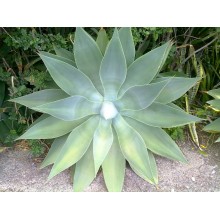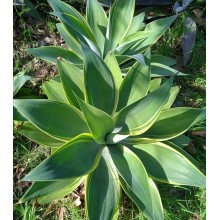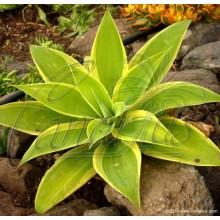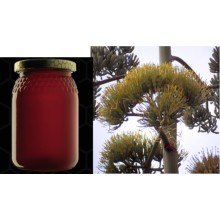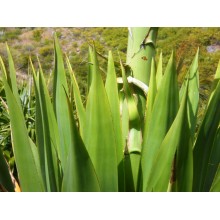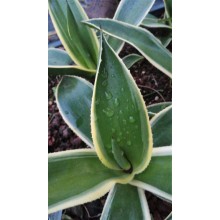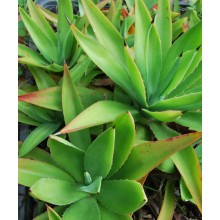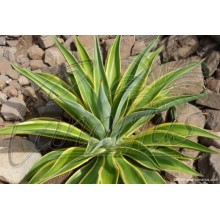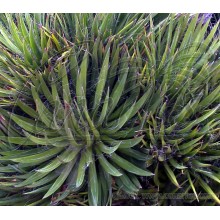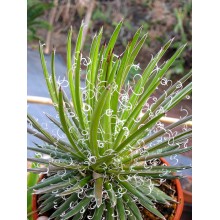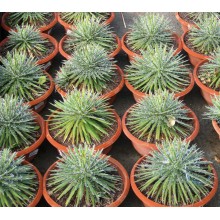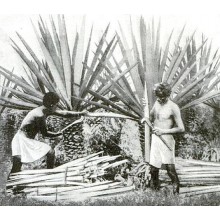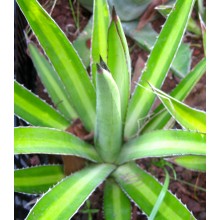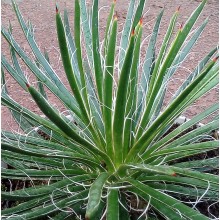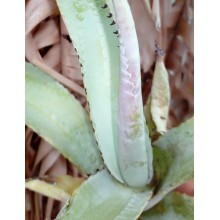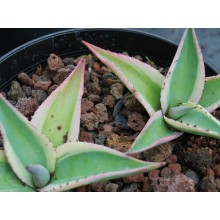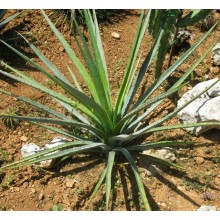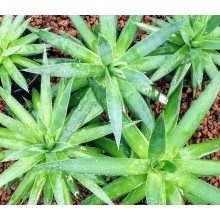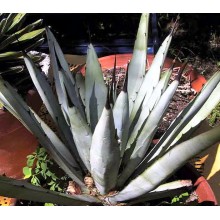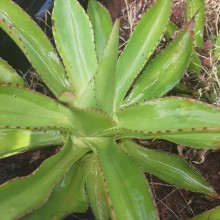Succulents There are 628 products.

World deserts and dry areas are home to the most interesting plants. Canarius offers an increasing selection of succulent plants of maximum quality, because they are grown outdoors, under the full sun of the Canary Islands.
Succulents or "fat plants" are water-retaining species, adapted to dry conditions. They store succum (juice, water) in their leaves, stems or roots, and often show a stout and fleshy appearance.
Subcategories
-
Agave
Agave is a genus of succulent plants from America. Some species grow in cold areas and take hard frost, while some others live in tropical climates. Some are tiny dwarfs and some are giants, up to 2 or 3 m wide.
Cold hardy agaves can create an exotic effect in your garden. Agave species make fine companions to palms or cacti. Variegated agaves are incredibly sought after by collectors. Our web shop offers an ever changing selection of species. We ship bare rooted plants, unless otherwise specified.
-
Aloe, Gasteria & Haworthia
Aloe, Gasteria and Haworthia are three related genera, comprising hundreds of succulent plants. They are all easily grown in pots. A few adapt to low-light levels of indoor conditions and can be grown as house plants.
- Aloe is a genus of about 400 species, native to Africa, Arabia and Madagascar. Small or dwarf aloes are becoming especially popular in colder climates as they can be taken indoors during the hardest months.
- Gasteria includes some 80 species endemic to South Africa, known for their spectacular leaves which are glossy, mottled and textured. They bloom in Spring-Summer with long spikes of small orange flowers. Some species are so variable that we offer particular clones from specific locations.
- Haworthia is a genus endemic to South Africa with about 70 species and a number of local subspecies, varieties and forms. Leaves are often banded, speckled, dotted, or semi-translucent and show wide variations.
-
Crassulaceae
This is a new, growing section of species from the family Crassulaceae. There are about 1,400 species in 33 genera and their distribution is worldwide, but mostly occur in the Northern Hemisphere and Southern Africa, especially in dry habitats. Here you can buy healthy, sun-hardened plants grown in the Canary Islands and shipped to your home.
-
Mesembs
This group of desert plants is briefly named Mesembs because they belong to a botanical family formerly named Mesembryanthemaceae. There are almost 2.000 species, mainly found in Southern Africa, with extreme adaptations to dry habitats. Some are called "living stones", as they look like pebbles. Many are easy to grow and their main need is full sun. Some are difficult because they grow in truly extreme areas.
Our Web Shop offers sun grown healthy plants, with compact and colourful leaves. Some plants are sold as cuttings, and others as rooted plants, of at least two years old.
-
Sansevieria
Recently assigned to the family Asparagaceae, the genus Sansevieria counts about 70 species, nearly all native to Africa, Arabia and Madagascar. Perennial herbs adapted to dry habitats with stiff, succulent leaves, their length ranges from a few centimeters to 2 meters. Sansevieria trifasciata and its many cultivars are among the most popular houseplants, popularly called mother in law's tongue. A well grown plant usually produces a spike of many white, richly scented flowers and then orange berries. Even the rarest species are resistant to neglect, provided you keep them from frost in winter and scorching sun in summer.
-
Hoya
Hoyas are twining vines, with showy exotic flowers, from the rainforests in Asia and Oceania. Most species grow in bright shade or morning sun, but they will also grow indoors as house plants. They are well suited for baskets, trellises or ladders. They tolerate a few weeks of drought but they are sensitive to frost and cold. Many hoyas are easy to grow and bloom, while some are tricky and rare.
-
Asclepiads
Asclepiads or Asclepiadoideae are a subfamily in the Apocynaceae, with about 2900 species. There are lots of leafless stem succulents but also perennial herbs, shrubs, lianas or rarely trees. They produce remarkable flowers, for the complex mechanisms they have developed for pollination. Many species produce an unusual fragrance, often called "carrion", and attracts flies for pollination. -
Caudiciforms
These plants from dry areas produce an unusually thick stem, the caudex. They are also called pachycauls and they have a disproportionately thick trunk, often with few branches. The caudex can be hidden underground, but in most cases they grow upwards, forming spectacular trees. The largest caudiciforms in the world are the baobabs. -
Other succulents
Here you will find all those species of desert plants that are not included in their own category. We will place here all plants from unusual families, other than Agaves, Aloes, Crassulaceae, Sansevieria, Mesembs, Epiphytic cacti, etc.
-
Agave attenuata ssp. attenuata
Agave attenuata ssp. attenuata
Cutting of 10-15 cm diameter. A classic of all times in subtropical gardening. It is a mid sized spineless agave native to the cooler plateau of Central Mexico. Rosettes achieve 1 m (3 ft) with spectacular wide, green-blue waxy leaves.
19,80 € -
Agave attenuata variegata Tenerife-Extra Large
Agave attenuata variegata Tenerife-Extra Large
65 cm diameter. This is a variegated form of Agave attenuata with striped leaves. It is unique because it appeared in Tenerife from a normal plant...
67,50 € -
Agave attenuata variegata Tenerife-Large
Agave attenuata variegata Tenerife-Large
40-50 cm. This is a variegated form of Agave attenuata with striped leaves. It is unique because it appeared in Tenerife from a normal plant...
44,50 € -
Agave Bee Honey - Agave americana
Agave Bee Honey - Agave americana
Agave bee honey in Tenerife is produced in different sloping dry and sloping areas of the island where Agave americana blooms.This honey has an intense, pungent aroma aroma. Its amber colour varies a lot from yellow to brown, and also the degree of crystallization, depending on the other plants that a e blooming simultaneously
17,50 € -
Agave caribaeicola
Agave caribaeicola
Hard to find agave native to a group of islands in the lesser Caribbean islands. It is definitely a winner, with a nicely shaped rosette of bright green S-shaped leaves with red toothed margins. It is a tropical species and should be kept above 8 C and protected from frost or hail.
26,40 € -
Agave cundinamarcensis 'Marginata'
Agave cundinamarcensis 'Marginata'
Supreme variegated agave with glossy wide leaves, which are dark green inside and richly coloured in the margins. Agave cundinamarcensis is a tropical species,from Colombia, and while it is very easy to grow, it must be kept away from frost and hail and it will also enjoy abundant water in full summer.
34,00 € -
Agave demeesteriana 'Espinas'
Agave demeesteriana 'Espinas'
This is an uncommon clone of Agave demeesteriana, which is usually represented by clones with spineless leaf margins. Leaves are elegantly arching, dark-green in colour, with a light glaucous wax, marginal spines are soft and almost unharmful. It is a small sized species which will hardly exceed 60 cm in diameter.
16,20 € -
Agave demeesteriana 'Marginata'
Agave demeesteriana 'Marginata'
Bright, yellow margins enhance the elegantly arching leaves. This agave is an easy growing spineless beauty.
18,60 € -
Agave filifera
Agave filifera
NEW ! - 14-18 cm. Compact species, widespread in centralMexico where it grows at high elevations. It forms a dense, solitaryrosette with typical white "hairs" on the leaves. It tolerates dry frost.
19,80 € -
Agave filifera 'Leopoldii'
Agave filifera 'Leopoldii'
Old miniature hybrid. Exceptional white fibres coil and twist on the margins of the stiff, glossy leaves. It is a cross of two subspecies of Agave filifera.
12,00 € -
Agave filifera 'Leopoldii' - Large Size
Agave filifera 'Leopoldii' - Large Size
Old miniature hybrid. Exceptional white fibres coil and twist on the margins of the stiff, glossy leaves. It is a cross of two subspecies of Agave filifera.
33,00 € -
Agave fourcroydes
Agave fourcroydes
This Mexican agave is a very od sterile hybrid, planted commercialy for the production of henequen fibres, similar to the sisal fibres produced by other agave species. Also the henenquen liquour is made out of this species. It is frost hardy to about -5 C or even less.
11,30 € -
Agave geminiflora
Agave geminiflora
This agave is a joy for the garden, because of its small size and non aggressive leaves. These are flexible, narrow, dark green and unarmed.
20,80 € -
Agave guiengola
Agave guiengola
This Agave has a unique look because it has few very wide and thick leaves. Leaves are blue and dark edged and form a truly elegant rosette. It takes its name from where it grows: in the sacred mountain and archeologicar site of Guiengola, in Oaxaca, Mexico.
27,50 € -
Agave guiengola 'Creme Brulee'
Agave guiengola 'Creme Brulee'
Agave guiengola is one of the most beautiful and different of all agaves, because of its elegant crown made of few very thick leaves, with regularly spaced dark spines.
41,50 € -
Agave karwinskii Teotitlan
Agave karwinskii Teotitlan
14-18 cm. A different-looking agave with thin erect stems up to 2 m tall. This species grows somehow like a Yucca. It is native to Oaxaca,and Puebla, in Mexico. This particular form was collected in by the town of Teotitlán del Valle, in Oaxaca, at about 1700 m.
11,70 € -
Agave kavandivi
Agave kavandivi
This Agave was described in 2013, from a population in "Kava Ndvi" mountain, in Oaxaca, Mexico. It is absolutely ornamental, with bright pale green rosettes with sraight smooth-margined leaves.
25,30 € -
Agave macroacantha Blue Form
Agave macroacantha Blue Form
NEW ! - 14-18 cm. Spectacular Agave with grey-blue leaves and dark brown spines.
11,90 € -
Agave Mitis
Agave Mitis
Also known under the name Agave celsii, this medium-sized species grows in humid, high altitude forests in the Mexican states of Hidalgo, San Luis Potosi and Tamaulipas.
18,60 €
At the moment there are few products in this category Succulents

























